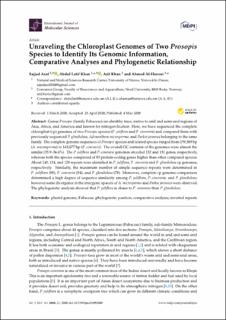| dc.contributor.author | Asaf, Sajjad | |
| dc.contributor.author | Khan, Abdul Latif | |
| dc.contributor.author | Khan, Arif | |
| dc.contributor.author | Al-Harrasi, Ahmed | |
| dc.date.accessioned | 2020-07-07T07:03:40Z | |
| dc.date.available | 2020-07-07T07:03:40Z | |
| dc.date.created | 2020-05-25T11:05:04Z | |
| dc.date.issued | 2020 | |
| dc.identifier.citation | Asaf, S., Khan, A. L., Khan, A. & Al-Harrasi, A. (2020). Unraveling the chloroplast genomes of two Prosopis species to identify its genomic information, comparative analyses and phylogenetic relationship. International Journal of Molecular Sciences, 21(9). doi: | en_US |
| dc.identifier.issn | 1422-0067 | |
| dc.identifier.uri | https://hdl.handle.net/11250/2660885 | |
| dc.description.abstract | Genus Prosopis (family Fabaceae) are shrubby trees, native to arid and semi-arid regions of Asia, Africa, and America and known for nitrogen fixation. Here, we have sequenced the complete chloroplast (cp) genomes of two Prosopis species (P. juliflora and P. cineraria) and compared them with previously sequenced P. glandulosa, Adenanthera microsperma, and Parkia javanica belonging to the same family. The complete genome sequences of Prosopis species and related species ranged from 159,389 bp (A. microsperma) to 163,677 bp (P. cineraria). The overall GC contents of the genomes were almost the similar (35.9–36.6%). The P. juliflora and P. cineraria genomes encoded 132 and 131 genes, respectively, whereas both the species comprised of 85 protein-coding genes higher than other compared species. About 140, 134, and 129 repeats were identified in P. juliflora, P. cineraria and P. glandulosa cp genomes, respectively. Similarly, the maximum number of simple sequence repeats were determined in P. juliflora (88), P. cineraria (84), and P. glandulosa (78). Moreover, complete cp genome comparison determined a high degree of sequence similarity among P. juliflora, P. cineraria, and P. glandulosa, however some divergence in the intergenic spacers of A. microsperma and Parkia javanica were observed. The phylogenetic analysis showed that P. juliflora is closer to P. cineraria than P. glandulosa. | en_US |
| dc.language.iso | eng | en_US |
| dc.publisher | MDPI | en_US |
| dc.rights | Navngivelse 4.0 Internasjonal | * |
| dc.rights.uri | http://creativecommons.org/licenses/by/4.0/deed.no | * |
| dc.title | Unraveling the chloroplast genomes of two Prosopis species to identify its genomic information, comparative analyses and phylogenetic relationship | en_US |
| dc.type | Peer reviewed | en_US |
| dc.type | Journal article | en_US |
| dc.description.version | publishedVersion | en_US |
| dc.rights.holder | © 2020 The Author(s) | en_US |
| dc.subject.nsi | VDP::Matematikk og Naturvitenskap: 400::Basale biofag: 470::Genetikk og genomikk: 474 | en_US |
| dc.source.pagenumber | 23 | en_US |
| dc.source.volume | 21 | en_US |
| dc.source.journal | International Journal of Molecular Sciences | en_US |
| dc.source.issue | 9 | en_US |
| dc.identifier.doi | 10.3390/ijms21093280 | |
| dc.identifier.cristin | 1812412 | |
| dc.relation.project | Research Council of Oman: BFP/RGP/EBR/18/005 | en_US |

